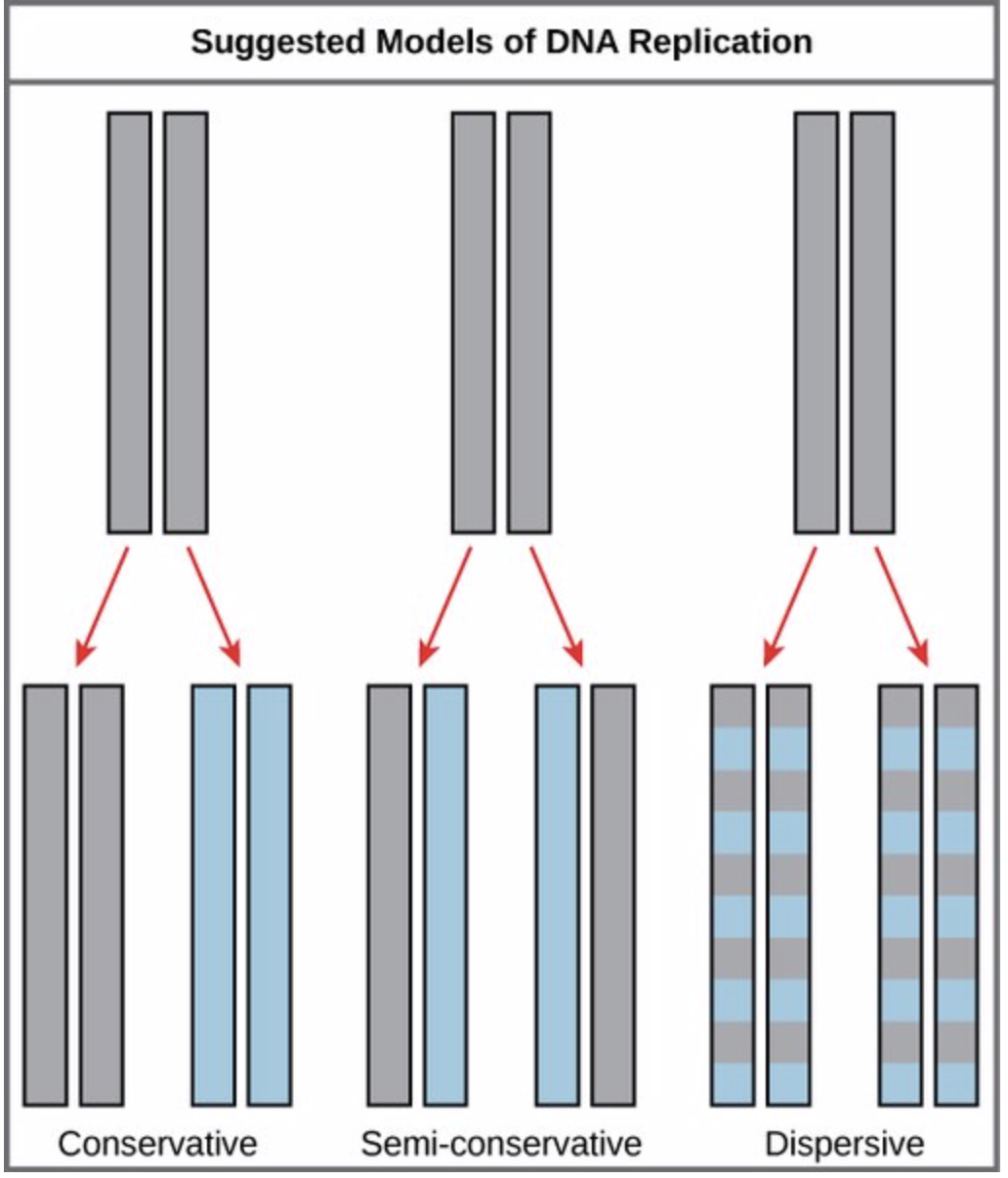
Semi-conservative model of DNA replication was confirmed by
(a) Taylor, Woods and Hughes.
(b) Messelson and stahl
(c) Nirenberg and Khorona
(d) Watson and Crick
Answer
561k+ views
Hint: The duo thus started their experiment by selecting two nitrogen isotopes, the common and lighter 14N, and the rare and heavier 15N (so- called "heavy" nitrogen) as their labels and as their sedimentation process, a technique is known as cesium chloride (CsCl) equilibrium density gradient centrifugation.
Complete answer:
- It seemed most likely that the semi- conservative model in which each strand of DNA serves as a blueprint for creating a new, complementary strand was based on the structure of DNA.
- The models were tested by Meselson and Stahl, who used isotopes of nitrogen to mark the DNA of bacteria through generations.

- Meselson and Stahl confirmed, from the DNA labelling trends they saw, that DNA is repeated semi- conservatively.
- The two strands of DNA unwind from each other in the semi- conservative replication model, and each serves as a template for a new, complementary strand to synthesize. Two DNA molecules with one initial strand and one new strand result in this.
Additional information:
- In a $^{15}N$ medium, they cultured bacteria. $^{15}N$ is a heavy nitrogen isotope, so the synthesized DNA has a high density. The bacteria were then moved to a $^{14}N$ medium and DNA was isolated at different intervals, corresponding to cycles 0, 1, and 2 of replication. The DNA had all of the intermediate density after one replication period.
- This rules out the conservative replication model, which assumes that there will be both DNA for heavy density and DNA for light density, but there will be no intermediate density. This outcome is consistent with the model of semiconservative replication, which predicts that one 15N- labeled DNA strand and one $^{14}N$ - labeled DNA strand will be composed of all DNA molecules.
- The result does not rule out the dispersive replication model, which also predicts that all DNA consisting of interspersed double-stranded $^{15}N$-labeled and $^{14}N$- labeled segments would be of intermediate density.
- Two bands of DNA were seen after two replication cycles, one with intermediate density and one with light density. This outcome is exactly what is expected by the semiconservative model: half should be DNA of intermediate density $^{15}N$ - $^{14}N$ and half should be DNA of light density $^{14}N$ - $^{14}N$.
So, the correct answer is ‘(b) Messelson and Stahl.
Note: This outcome rules out the dispersive replication model, which predicts that the DNA density of all DNA molecules will gradually decrease after replication cycle 1 so that no DNA intermediate density can remain in replication cycle 2. The model of semiconservative is right.
Complete answer:
- It seemed most likely that the semi- conservative model in which each strand of DNA serves as a blueprint for creating a new, complementary strand was based on the structure of DNA.
- The models were tested by Meselson and Stahl, who used isotopes of nitrogen to mark the DNA of bacteria through generations.

- Meselson and Stahl confirmed, from the DNA labelling trends they saw, that DNA is repeated semi- conservatively.
- The two strands of DNA unwind from each other in the semi- conservative replication model, and each serves as a template for a new, complementary strand to synthesize. Two DNA molecules with one initial strand and one new strand result in this.
Additional information:
- In a $^{15}N$ medium, they cultured bacteria. $^{15}N$ is a heavy nitrogen isotope, so the synthesized DNA has a high density. The bacteria were then moved to a $^{14}N$ medium and DNA was isolated at different intervals, corresponding to cycles 0, 1, and 2 of replication. The DNA had all of the intermediate density after one replication period.
- This rules out the conservative replication model, which assumes that there will be both DNA for heavy density and DNA for light density, but there will be no intermediate density. This outcome is consistent with the model of semiconservative replication, which predicts that one 15N- labeled DNA strand and one $^{14}N$ - labeled DNA strand will be composed of all DNA molecules.
- The result does not rule out the dispersive replication model, which also predicts that all DNA consisting of interspersed double-stranded $^{15}N$-labeled and $^{14}N$- labeled segments would be of intermediate density.
- Two bands of DNA were seen after two replication cycles, one with intermediate density and one with light density. This outcome is exactly what is expected by the semiconservative model: half should be DNA of intermediate density $^{15}N$ - $^{14}N$ and half should be DNA of light density $^{14}N$ - $^{14}N$.
So, the correct answer is ‘(b) Messelson and Stahl.
Note: This outcome rules out the dispersive replication model, which predicts that the DNA density of all DNA molecules will gradually decrease after replication cycle 1 so that no DNA intermediate density can remain in replication cycle 2. The model of semiconservative is right.
Recently Updated Pages
Master Class 11 Economics: Engaging Questions & Answers for Success

Master Class 11 English: Engaging Questions & Answers for Success

Master Class 11 Social Science: Engaging Questions & Answers for Success

Master Class 11 Biology: Engaging Questions & Answers for Success

Class 11 Question and Answer - Your Ultimate Solutions Guide

Master Class 11 Business Studies: Engaging Questions & Answers for Success

Trending doubts
10 examples of friction in our daily life

One Metric ton is equal to kg A 10000 B 1000 C 100 class 11 physics CBSE

Difference Between Prokaryotic Cells and Eukaryotic Cells

1 Quintal is equal to a 110 kg b 10 kg c 100kg d 1000 class 11 physics CBSE

State the laws of reflection of light

Explain zero factorial class 11 maths CBSE




